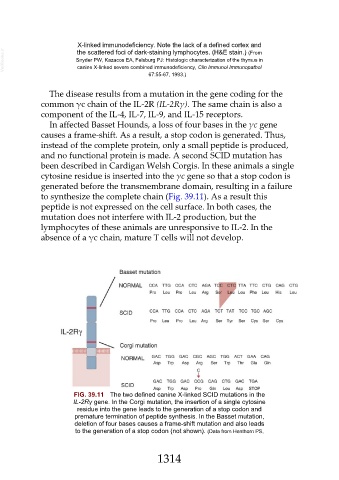Page 1314 - Veterinary Immunology, 10th Edition
P. 1314
X-linked immunodeficiency. Note the lack of a defined cortex and
VetBooks.ir Snyder PW, Kazacos EA, Felsburg PJ: Histologic characterization of the thymus in
the scattered foci of dark-staining lymphocytes. (H&E stain.) (From
canine X-linked severe combined immunodeficiency, Clin Immunol Immunopathol
67:55-67, 1993.)
The disease results from a mutation in the gene coding for the
common γc chain of the IL-2R (IL-2Rγ). The same chain is also a
component of the IL-4, IL-7, IL-9, and IL-15 receptors.
In affected Basset Hounds, a loss of four bases in the γc gene
causes a frame-shift. As a result, a stop codon is generated. Thus,
instead of the complete protein, only a small peptide is produced,
and no functional protein is made. A second SCID mutation has
been described in Cardigan Welsh Corgis. In these animals a single
cytosine residue is inserted into the γc gene so that a stop codon is
generated before the transmembrane domain, resulting in a failure
to synthesize the complete chain (Fig. 39.11). As a result this
peptide is not expressed on the cell surface. In both cases, the
mutation does not interfere with IL-2 production, but the
lymphocytes of these animals are unresponsive to IL-2. In the
absence of a γc chain, mature T cells will not develop.
FIG. 39.11 The two defined canine X-linked SCID mutations in the
IL-2Rγ gene. In the Corgi mutation, the insertion of a single cytosine
residue into the gene leads to the generation of a stop codon and
premature termination of peptide synthesis. In the Basset mutation,
deletion of four bases causes a frame-shift mutation and also leads
to the generation of a stop codon (not shown). (Data from Henthorn PS,
1314

